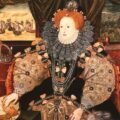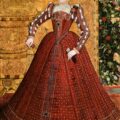Today we’re going to look at a portrait which is startlingly similar to last week’s Pelican Portrait, a portrait which almost looks like a mirror of the Pelican Portrait if you just glance at it quickly. Here it is, it is the Phoenix Portrait:-
The Phoenix Portrait was painted around the same time (perhaps a year later) as the Pelican Portrait and by the same artist, probably Nicholas Hilliard. Have a look at the portrait and see what symbols you can see, I’m struggling with this one!
Symbolism in The Phoenix Portrait
- The Phoenix – The portrait takes its name from the phoenix pendant which Elizabeth is wearing. The phoenix was used to symbolize sacrifice and rebirth, and the way that it rises from the ashes could speak of Elizabeth’s rise to power. The phoenix is also a symbol of Christ’s Resurrection and the promise of eternal life, and as only one phoenix lives at one time it may be a symbol of Elizabeth’s uniqueness. Another meaning of the phoenix is chastity, so it is another allusion to the Queen’s purity and virginity.
- Dress – Elizabeth is wearing a stunning costume, a French Gown decorated with pearls, embroidery and blackwork embroidery, as well as a spectacular ruff. It is a dress to impress and the black and gold colour speaks of Elizabeth’s wealth and status.
- Pearls – Again we have Elizbeth’s favourite jewellery and this time we have a strand around her waist, a girdle. Am I reading too much into this or could the positioning of those pearls, a symbol of purity and virginity, be speaking of her chastity?
- Red rose – The red rose is a symbol of love, beauty, secrecy, Christian martyrdom and the Virgin Mary, and the five petals of the rose were said to symbolize the five wounds of Christ. Could it be speaking of Elizabeth’s virginity and faith? I’m not sure.
- Ermine – I’m not sure whether the white furry bits at the bottom of the painting are a feathered fan or ermine. If it’s ermine then it’s another symbol of purity and also speaks of Elizabeth’s wealth and importance.
Does anyone have any idea if the leaf pattern on Elizabeth’s dress has any meaning? Can you see a symbol or message that I’ve missed? Let me know in the comments section below!









